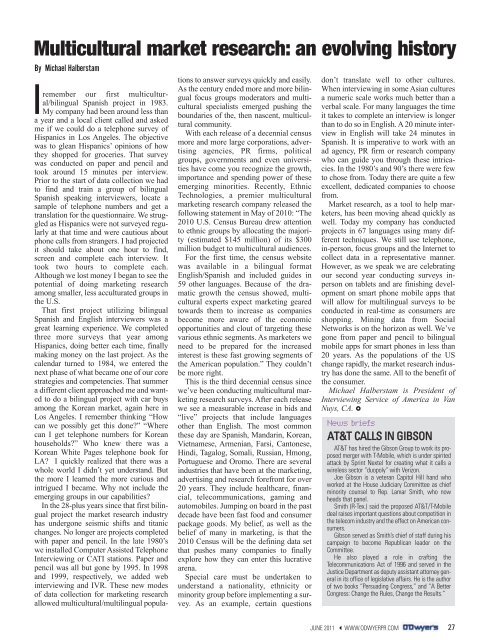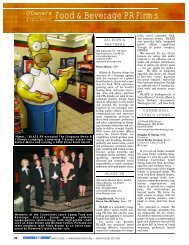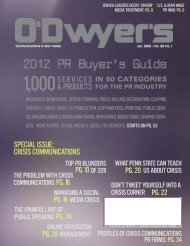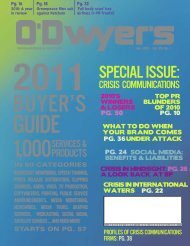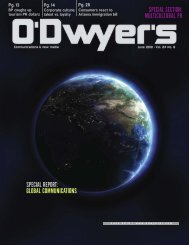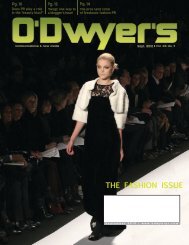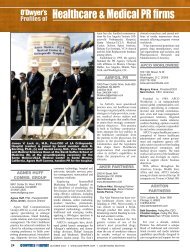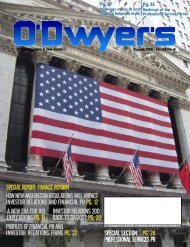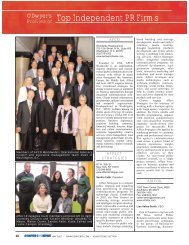INTERNATIONAL & MULTICULTURAL ISSUE - Odwyerpr.com
INTERNATIONAL & MULTICULTURAL ISSUE - Odwyerpr.com
INTERNATIONAL & MULTICULTURAL ISSUE - Odwyerpr.com
Create successful ePaper yourself
Turn your PDF publications into a flip-book with our unique Google optimized e-Paper software.
Multicultural market research: an evolving historyBy Michael HalberstamIremember our first multicultural/bilingualSpanish project in 1983.My <strong>com</strong>pany had been around less thana year and a local client called and askedme if we could do a telephone survey ofHispanics in Los Angeles. The objectivewas to glean Hispanics’ opinions of howthey shopped for groceries. That surveywas conducted on paper and pencil andtook around 15 minutes per interview.Prior to the start of data collection we hadto find and train a group of bilingualSpanish speaking interviewers, locate asample of telephone numbers and get atranslation for the questionnaire. We struggledas Hispanics were not surveyed regularlyat that time and were cautious aboutphone calls from strangers. I had projectedit should take about one hour to find,screen and <strong>com</strong>plete each interview. Ittook two hours to <strong>com</strong>plete each.Although we lost money I began to see thepotential of doing marketing researchamong smaller, less acculturated groups inthe U.S.That first project utilizing bilingualSpanish and English interviewers was agreat learning experience. We <strong>com</strong>pletedthree more surveys that year amongHispanics, doing better each time, finallymaking money on the last project. As thecalendar turned to 1984, we entered thenext phase of what became one of our corestrategies and <strong>com</strong>petencies. That summera different client approached me and wantedto do a bilingual project with car buysamong the Korean market, again here inLos Angeles. I remember thinking “Howcan we possibly get this done?” “Wherecan I get telephone numbers for Koreanhouseholds?” Who knew there was aKorean White Pages telephone book forLA? I quickly realized that there was awhole world I didn’t yet understand. Butthe more I learned the more curious andintrigued I became. Why not include theemerging groups in our capabilities?In the 28-plus years since that first bilingualproject the market research industryhas undergone seismic shifts and titanicchanges. No longer are projects <strong>com</strong>pletedwith paper and pencil. In the late 1980’swe installed Computer Assisted TelephoneInterviewing or CATI stations. Paper andpencil was all but gone by 1995. In 1998and 1999, respectively, we added webinterviewing and IVR. These new modesof data collection for marketing researchallowed multicultural/multilingual populationsto answer surveys quickly and easily.As the century ended more and more bilingualfocus groups moderators and multiculturalspecialists emerged pushing theboundaries of the, then nascent, multicultural<strong>com</strong>munity.With each release of a decennial censusmore and more large corporations, advertisingagencies, PR firms, politicalgroups, governments and even universitieshave <strong>com</strong>e you recognize the growth,importance and spending power of theseemerging minorities. Recently, EthnicTechnologies, a premier multiculturalmarketing research <strong>com</strong>pany released thefollowing statement in May of 2010: “The2010 U.S. Census Bureau drew attentionto ethnic groups by allocating the majority(estimated $145 million) of its $300million budget to multicultural audiences.For the first time, the census websitewas available in a bilingual formatEnglish/Spanish and included guides in59 other languages. Because of the dramaticgrowth the census showed, multiculturalexperts expect marketing gearedtowards them to increase as <strong>com</strong>paniesbe<strong>com</strong>e more aware of the economicopportunities and clout of targeting thesevarious ethnic segments. As marketers weneed to be prepared for the increasedinterest is these fast growing segments ofthe American population.” They couldn’tbe more right.This is the third decennial census sincewe’ve been conducting multicultural marketingresearch surveys. After each releasewe see a measurable increase in bids and“live” projects that include languagesother than English. The most <strong>com</strong>monthese day are Spanish, Mandarin, Korean,Vietnamese, Armenian, Farsi, Cantonese,Hindi, Tagalog, Somali, Russian, Hmong,Portuguese and Oromo. There are severalindustries that have been at the marketing,advertising and research forefront for over20 years. They include healthcare, financial,tele<strong>com</strong>munications, gaming andautomobiles. Jumping on board in the pastdecade have been fast food and consumerpackage goods. My belief, as well as thebelief of many in marketing, is that the2010 Census will be the defining data setthat pushes many <strong>com</strong>panies to finallyexplore how they can enter this lucrativearena.Special care must be undertaken tounderstand a nationality, ethnicity orminority group before implementing a survey.As an example, certain questionsdon’t translate well to other cultures.When interviewing in some Asian culturesa numeric scale works much better than averbal scale. For many languages the timeit takes to <strong>com</strong>plete an interview is longerthan to do so in English. A 20 minute interviewin English will take 24 minutes inSpanish. It is imperative to work with anad agency, PR firm or research <strong>com</strong>panywho can guide you through these intricacies.In the 1980’s and 90’s there were fewto chose from. Today there are quite a fewexcellent, dedicated <strong>com</strong>panies to choosefrom.Market research, as a tool to help marketers,has been moving ahead quickly aswell. Today my <strong>com</strong>pany has conductedprojects in 67 languages using many differenttechniques. We still use telephone,in-person, focus groups and the Internet tocollect data in a representative manner.However, as we speak we are celebratingour second year conducting surveys inpersonon tablets and are finishing developmenton smart phone mobile apps thatwill allow for multilingual surveys to beconducted in real-time as consumers areshopping. Mining data from SocialNetworks is on the horizon as well. We’vegone from paper and pencil to bilingualmobile apps for smart phones in less than20 years. As the populations of the USchange rapidly, the market research industryhas done the same. All to the benefit ofthe consumer.Michael Halberstam is President ofInterviewing Service of America in VanNuys, CA. News briefsAT&T CALLS IN GIBSONAT&T has hired the Gibson Group to work its proposedmerger with T-Mobile, which is under spiritedattack by Sprint Nextel for creating what it calls awireless sector “duopoly” with Verizon.Joe Gibson is a veteran Capitol Hill hand whoworked at the House Judiciary Committee as chiefminority counsel to Rep. Lamar Smith, who nowheads that panel.Smith (R-Tex.) said the proposed AT&T/T-Mobiledeal raises important questions about <strong>com</strong>petition inthe tele<strong>com</strong> industry and the effect on American consumers.Gibson served as Smith’s chief of staff during hiscampaign to be<strong>com</strong>e Republican leader on theCommittee.He also played a role in crafting theTele<strong>com</strong>munications Act of 1996 and served in theJustice Department as deputy assistant attorney generalin its office of legislative affairs. He is the authorof two books “Persuading Congress,” and “A BetterCongress: Change the Rules, Change the Results.”JUNE 2011 WWW.ODWYERPR.COM 27


